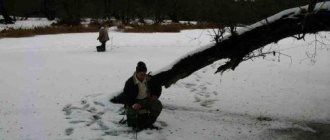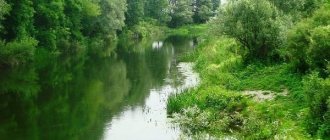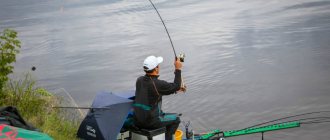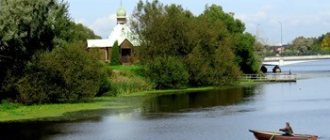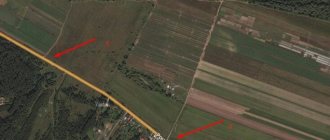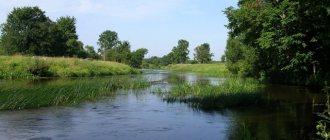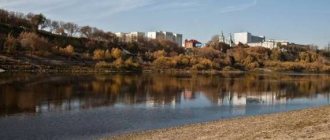Volkhov River 03/15/2015 11:41
One of the best places for fishing in the Leningrad and Novgorod regions is the Volkhov River.
This river originates from Lake Ilmen (by the way, this is the only river flowing from it). Then the Volkhov flows 224 kilometers along the Priilmenskaya Lowland. It is a large navigable river with many tributaries and a large drainage basin of 80,200 square meters. km. A hydroelectric power station was built on the Volkhov River, which, unfortunately, negatively affected fishing in the upper reaches of the river. Nevertheless, the Volkhov is one of the richest rivers in Russia.
The Volkhov flows into Lake Ladoga. But due to the fact that there is a very small difference in elevation between the source and the mouth of this river, sometimes an interesting natural phenomenon occurs: the Volkhov turns back! The river changes its course and moves not from Ilmen to Ladoga, but vice versa.
The most significant right tributaries of the Volkhov are the Pchevzha, Vyyka, Robeyka and Kava. The largest among the left tributaries are Kerest and Tigoda.
The average depth of the river is 4–5 meters, the maximum is 12 meters. The Volkhov is covered with ice at the end of November - December. Ice break-up occurs in mid-April.
general characteristics
The rivers of the Novgorod, Pskov, Tver and Leningrad regions carry water to the Volkhov. The territory of its basin is 80,200 km², with more than half of the area (61%) belonging to the Novgorod region. The length of the river is 224 km. When the Volkhov flows from Ilmen, its width is no more than 220 m. Downstream the channel widens to 350 m. The depth of the Volkhov River increases towards Lake Ladoga. Average depths reach 4–5 m, maximum depths – 15 m.
Volkhov is a typically flat river. The height difference between the source and the mouth is 13 m, which corresponds to an average slope of 0.06%. In the section from the source to the Pchevsky rapids, the slope is less - 0.007%, which is why it flows here more slowly, at a speed of 1 m/s.
Where is the best fishing on Volkhov?
Fish is caught in Volkhov both in summer and winter. But winter fishing is considered unsafe, since you can come across wormwood formed by warm springs. Nevertheless, there are always a lot of fans of winter fishing on this river.
In summer, fish in Volkhov are excellently caught on the current. A great place to sit with a bottom fishing rod on a boat or on the shore is a place near the Volkhov-Most station and in the Novaya Ladoga area. The mouths of the Volkhov tributaries can boast of a wonderful catch: Oskuya, Tigody, Pchevzhi, Keresti are the most catchy places. Closer to the mouth of the Volkhov, the fish are definitely better caught.
Less tasty places for fisherman are the middle and upper reaches of the Volkhov, which is connected with the Volkhov hydroelectric station located on the river. Because of the dam, fish from Ladoga cannot enter the Volkhov. However, it is impossible to say that there are no fish at all in the upper and middle reaches of the Volkhov: they fish quite well along the entire length of the river.
Known types of fish in this body of water, what kind of fish can be caught:
What kind of fish can you catch on the Volkhov River?
- Pike in Volkhov is found in very large sizes. The trophy may well reach a weight of 10–15 kg. Along the banks they catch and squint in 0.5 - 1 - 2 kg. This is one of the most popular types of fish for fishing on the Volkhov.
- Pike perch is a tasty predator that can be caught with a wobbler or jig. Belongs to the perch family. The average weight of pike perch caught in Volkhov is 0.5–1 kg, but larger specimens are also found. Spinning fishing for walleye is the most popular on the river.
- Perch is a fish weighing up to 2 kg, a popular object among amateur fishermen. Like pike perch, it spawns in early spring and is well caught in summer.
- Bream is a popular trophy; it can be caught well with a bottom fishing rod and reaches 0.8 m and 5–6 kg.
- Gustera is a schooling cyprinid fish, reminiscent of bream. In Volkhov it is good to fish with a bottom fishing rod. Dimensions up to 0.35 cm, weight up to 1.3 kg.
- Ide is a fish from the carp family; in Volkhov it reaches 0.5 m in length and weighs up to 2.5 kg, although there are also larger trophies.
- Asp is another common trophy of fisherman on the Volkhov from the carp family, reaching 0.3–0.4 meters in length.
- Bluefish is a carp fish, but not very large. Usually in Volkhov they catch bluefish weighing up to 0.5 kg. — White-eye is another fish from the large family of carp, widespread in the Volkhov River.
- The white-eye is similar to a bream, but its body is more elongated in length, and, on the contrary, flattened on the sides. Dimensions - from 0.3 to 0.4 m, weight - up to 1.5 kg.
- Whitefish (sigol). This fish is often called Volkhov whitefish and is one of the symbols of the river. Unfortunately, the former symbol... After the construction of the hydroelectric power station, whitefish are caught only once. Length – up to 0.6 m, weight – up to 3 kg.
- Crucian carp is one of the fishing objects that every angler should catch. And then fry it in sour cream.
- Catfish - In Volkhov, catfish are not very large, but quite weighty. They are usually caught with a bunch of worms using bottom tackle.
- Burbot is a lazy, fat predator up to 1.2 m long. In Volkhov, of course, you will not find burbots as large as in Siberia - weighing 18 kilos, but there are very good specimens.
- Eel is a valuable oily fish, similar to a snake. They catch it mainly in the dark, since the eel prefers a nocturnal lifestyle.
- Loach is a smaller, but also very fatty and tasty fish, 0.2–0.3 m long. It is excellently caught in Volkhov on the hook of a float rod.
Food, freeze-up, ice drift, flood
The Volkhov is fed by melting snow, and in summer and autumn the water level is maintained by rain.
By mid-November, thin ice forms on the surface of the river. A strong ice cover is established by December, and by the end of February its thickness reaches 70–80 cm. An amazing natural phenomenon is associated with the freeze-up period, which occurs only on northern rivers.
We recommend reading: Rivers of Ryazan and regions on the map, list, description, fishing
For the first time on the Volkhov, scientists discovered and described pyatras - ice formations shaped like mushrooms that attach to the bottom of the riverbed.
The river opens in April and is free of ice in 10-20 days.
The annual flow of Volkhov is 593 m³/s, according to some sources – 586 m³/s. Up to 70% of the runoff occurs during spring floods. During this period, the water level in the riverbed rises to 3 m, and in some years to 6-7 m. The river overflows its banks and floods nearby settlements.
Where is the best place to fish in the river?
In Volkhov, fish are caught not only in summer, but also in winter. However, winter is considered unsafe, because there you can come across wormwood, which is created by warm springs. Despite this, there are many fans of winter fishing. In summer, fish are excellently caught on the current. A wonderful place to sit with a bottom fishing rod on the shore or on a boat. Near the Volkhov-Most station there is a great place for fishing. The river's tributary mouths also boast excellent catches. These estuaries include: Tigody, Oskuya, Keresti and Pchevzhi. Such places are considered the most catchy. But the fishing is better closer to the mouth of the Volkhov.
There are also not so tasty places for fishermen - the upper and middle reaches of the river. This is all connected with the Volkhov hydroelectric power station, which is located there. Because of the dam, fish cannot go from Ladoga to Volkhov. However, it cannot be said that there are no fish at all in the upper and middle reaches of the river. There are times when the bite is excellent.
Bridges
The banks of the Volkhov are connected by numerous crossings.
We recommend reading: Ik River on the map of Bashkiria, fishing and recreation
There are 11 road bridges across the river:
- In Veliky Novgorod (named after Alexander Nevsky, Kolmovsky and Derevyanitsky).
- In the village of Kotovitsy.
- Near the village of Sitno.
- Near the village of Selishchi.
- Between the village of Krasnofarforny and the village. Georgian.
- In Kirishi.
- In Volkhov (Ilyinsky and the bridge between the Simankovo and Plekhanovo microdistricts).
- On the M18 road to the village of Issad.
Railway bridges were built:
- Near Volkhov Bridge.
- Between the railway station Volkhov-Pristan and the city of Kirishi.
- Between the railway station Thresholds and Kukol.
- Between the railway station Volkhovstroy-1 and Volkhovstroy-2.
In ancient times, the Great Bridge was built across the Volkhov in Novgorod, on which city residents resolved disputes that arose between them, proving their case in a fist fight. This bridge has not survived to this day; a modern pedestrian bridge was built in its place.
In addition, the banks are connected by a four-span pipeline bridge in Kirishi and the Volkhov hydroelectric power station dam.
Fishing near the village of Berezhki in 2018-2019
There is a certain water area located here, namely in the southeast of St. Petersburg. The places are picturesque and there are almost no people here. So fishermen come here not only for big catches, but also just to relax in the fresh air in silence. The section of the river in the area of the village itself should be called calm and without sharp turns. The relief bottom is calm and uniform. There are no large differences in depth. In such a place the width of the river is 200 meters. The bottom structure is predominantly sandy; muddy areas can be seen in the coastal zone. Aquatic vegetation also grows there: reeds, reeds, sedges, egg capsules, and so on.
In this area, fishermen can find a fairly diverse species composition of fish. The following are often caught on the hook: burbot, pike, pike perch, perch, bream, ruffe, ide, silver bream, bleak and others. The most interesting and productive fishing takes place in open water during the warm season. after all, at such times it is allowed to use different gear or set up camp right by the water.
At this time, spinners use jig fishing methods. There is also wobbler fishing, fishing with oscillating and rotating spoons. When a predator is hunting near the surface, topwaters are used, which allows you to catch an active predator. Pike perch comes out to shallow riffles at night, so minnow wobblers will also come in handy during this period.
As for peaceful fish, they are caught with float and bottom gear. Most often, fishermen use a moss rod or a classic feeder. On the feeder, feeders weighing about 100 grams are used. But the retrieve is caught with medium and light rigs. As for baits, the most popular of them is the worm. Less commonly, they can use caddisfly larvae, maggots and corn.
Village of Krenitsy
Another favorite place for fishermen is the river mouth near the village of Krenitsy. The city of Novaya Ladoga is also located nearby. There is a gentle current, a muddy bottom with a depth of up to 3.5 meters, and in some places there is a sandy shore. The river is navigable along its entire length. Mostly at the mouth of the river they catch perch, pike perch, silver bream, ide, roach, ruffe, sabrefish, asp, smelt, eel and so on. Typically, fishing here takes place on boats, however, there are those who like to fish with a feeder or donka.
The most important thing to remember is the stormy Lake Ladoga, as well as the dangerous squally wind. He is capable of turning over boats and boats. If we talk about bait, fishermen take a bunch of worms. Groundbait is also used successfully. Usually, they catch bream, bream, ide, silver bream and catfish. Some fishermen come to the mouth of the river for large specimens of catfish - up to 15 kg. It is better to catch them at night in deep holes.
But spinning fishing is still the most popular fishing. Trophy specimens of pike perch, pike, perch and other predators are found in huge quantities. If we talk about the size of the pikes that were caught here, they reached 14-15 kg. Acne is less common. Only few people know that in such a place you can still catch trout.
Largest settlements
People have settled on the banks of the Volkhov since ancient times, starting in 700. Let's look at the most famous settlements.
Veliky Novgorod (until 1999 – Novgorod)
– the oldest city in Russia with a rich cultural and historical heritage. Here, from 1136 to 1478, the first free republic existed in feudal Rus'.
The village of Krasnofarforny (formerly the village of Botanovka)
located 83 km from Veliky Novgorod. In 1898, Ivan Kuznetsov built the Georgian Porcelain Factory nearby. Thanks to the development of the porcelain business, the village received its name in 1919.
Kirishi city
first mentioned in 1693 as a village. The basis of its economy is the petrochemical industry. In the 1990s. Kirishi became known for the environmental movement against harmful emissions from the biochemical plant. The events were reflected in the documentary film “Us”.
Volkhov city
has an interesting history of origin, and it is connected with the quiet village of Zvanka, located on the banks of the Volkhov. At the beginning of the 20th century, the Obukhovo-Vologda railway passed through the village, Zvanka turned into a railway station and began to develop rapidly. In the 20s last century, a workers’ settlement arose near the station in connection with the construction of the Volkhov hydroelectric power station. In 1933, the construction workers’ settlement was merged with Zvanka and other settlements, and thus the city of Volkhovstroy appeared. Since 1940 it has been named Volkhov.
We recommend reading: Medveditsa River Tver region: map, description, rafting and fishing
Village Staraya Ladoga
has an ancient history. The fact that people lived in these places for a very long time is confirmed by archaeological finds. In 2015, a site of an ancient man from the Neolithic era (3rd millennium BC) was discovered near Staraya Ladoga.
The Novgorod Chronicle claims that Ladoga is the first capital of Rus', because the Varangian Rurik (862–864) was called here to reign. They say that here is the grave of Prophetic Oleg.
Ladoga had an advantageous geographical position; it was located on the route “from the Varangians to the Greeks.” During the times of Novgorod Rus, the Staraya Ladoga Fortress was a kind of border point where sea vessels that were unable to overcome the rapids of the Volkhov stopped.
City of Novaya Ladoga
owes its origin to Peter I. In the XIV–XV centuries. On this site stood the Nikolo-Medvedsky Monastery. By order of Peter I, a shipyard was founded next to it, and in 1704 the city of Novaya Ladoga was founded.
Gray-haired Volkhov
Volkhov. The third largest river in the Leningrad region. But for some reason, the first thing I remember when I hear this name is the man on the throne from the label of the Gray Volkhov vodka, produced in Kirishi in the late 90s. It so happened that we haven’t fished on Volkhov yet. We need to correct the situation.
We leave early, around 4 am. 160 kilometers of free morning road and we are there. It's about six o'clock. It immediately turns out that I took the camera, but forgot the memory card for it. Therefore, the photographs in this report will be so-so - I photographed with a boot.
Fishing on Volkhov
On the opposite bank there are already several cars and tents of fishermen who arrived for the night:
The width of the Volkhov River at the fishing spot is approximately 150-200 meters. From the shore it is clear that the current in the channel is powerful and fast, although under the banks there are areas with reverse flow and almost stagnant water:
Fishing on Volkhov
We quickly arrange the feeders:
Fishing on Volkhov
It immediately becomes clear that this place is almost unsuitable for feeder fishing - the riverbed is too close to the shore:
Fishing on Volkhov
Measuring depth from the shore with a Deeper wireless echo sounder shows a hole directly under the shore with an average depth of about 9 meters:
In addition, the current is so strong that the feeders simply roll along the bottom. Apparently, there is nothing to do with a feeder lighter than 120 grams on the Volkhov riverbed in this place.
We take out float rods to fish near the shore. A finger-sized bleak is caught on a float in the surface layers of the water. It bites almost instantly, you just need to throw the bait into the water:
Fishing on Volkhov
But catching bleak is boring, and you have to constantly monitor the float - the current carries it away quite quickly, even right next to the shore.
As a result, we decide to change place. We find a more suitable area with a coastal sandbar:
Fishing on Volkhov
The depth gradually increases and at the point where the feeders are cast it ranges from 1.5 to 2.5 meters. There is grass at the bottom. About thirty meters from the bank of the Volkhov, a riverbed and a large hole with a strong current begin:
Bites on the feeder begin with the first cast. First the sop:
Fishing on Volkhov
They are joined by roaches:
Fishing on Volkhov
We fish with maggots, worms and corn. Corn is in greatest demand:
Fishing on Volkhov
A lot of small change about the size of a palm, which is sent back:
Fishing on Volkhov
Finally, after a short struggle, undergrowth reaches the shore:
Fishing on Volkhov
From time to time gusts of wind roll along the Volkhov, the tip of the feeder is shaken by a wave, so you have to hold the feeder in your hands so as not to miss a bite. We both have phantom feeders, and we get bites in the hand very clearly, even on a fiberglass rod:
Fishing on Volkhov
At one point, a “give me the stick” bite occurs. At the other end of the cord, something resists like a steam locomotive. It’s going hard and it feels like it’s a large bream, we’re preparing the landing net... we’re pulling it out.... It turns out that this is quite a large ide.
Here it is, the fish of my dreams - YAZZYY! Took it for corn:
Fishing on Volkhov. Ide
On the second feeder, also on corn, a second ide is immediately caught. Then comes a series of roaches:
Fishing on Volkhov. Roach
Fishing on Volkhov. Podleschik
Fishing on Volkhov
Fishing on Volkhov
The fish tank is filled with the most interesting specimens, the little things float away to grow:
Fishing on Volkhov
Well, the first fishing trip on Volkhov turned out to be quite successful:
Fishing on Volkhov
In general, if you compare it with something, the river is quite similar in species composition to Lovat. Not surprisingly, however, these rivers are connected through Lake Ilmen. One of the differences is a much faster current (at least in the area where we were), which must be taken into account when feeder fishing.
We will definitely come back for fishing on Volkhov. And our immediate plans include a three-day fishing trip to Lovat.
More on the topic:
A map of all our posts is here
Shore fishing spots
Excellent places for fishing from the shore are located near the Volkhov Most station. Here you can find a flat section of the coast and have good fishing with feeder gear. Here you can catch large roach, bream and bluegill on the feeder.
Closer to the bridge, significant depths begin next to the shore, which gives the angler the opportunity to fish with float gear. Near the bridge they are consistently biting on the float:
Fans of coastal spinning fishing should go to the Novaya Ladoga area, where they can successfully catch pike perch and large perch. Very fishing places are in Chudovo, where one of the tributaries of the Volkhov, the Kerest River, flows.
You can fish from the shore in the Volkhov region at the mouth of the Oskuya and Pchevzha rivers. There are also many places in the lower reaches of the Volkhov River where effective shore fishing is possible.
Many good places for fishing from the shore are located in the Chudovsky district near the village of Gruzino. The village is located right on the river bank, which leaves a certain imprint on the behavior of the local fish. Due to strong fishing pressure, local fish behave extremely carefully. However, these places constantly attract anglers, which is primarily due to the convenient access to the water. Spinning anglers catch pike and perch in this area. Feeders can count on catching large bream.
Fishing spots
Lake Ladoga is covered with many islands, and almost half of the entire body of water is indented by bays. There are a huge number of places for fishing on the lake, and the variety of fish that lives here will not leave any fisherman, even a very experienced one, indifferent.
Each species of fish lives only in a certain place of Ladoga, therefore, when going fishing, you need to know in which part of the lake you can catch this or that individual. Smelt is found in almost any part of the lake, with the exception of the central one. But, for example, in the northwestern part of the reservoir you can catch
One of the most popular and catching places is the Novoladozhsky Canal, which is located 40 kilometers from St. Petersburg. The bite here is always good, the access roads are also excellent, so a lot of fishing enthusiasts gather here.
You can catch:
- Roach.
- Crucian carp.
- Pike perch.
- Perch.
The fish found are mostly of medium size; large specimens are rare here.
Winter fishing is very popular in the village of Lednevo.
The most successful place for catching predatory fish, such as perch or pike, is the mouth of the Kobona River.
A place rich in roach, pike, and perch is the village of Krenitsa, where the Volkhovets River flows into Lake Ladoga. The area is very popular not only among local residents, but also far beyond the Leningrad region, since the catches here are truly always impressive.
How to catch more fish? I have been actively fishing for quite some time and have found many ways to improve the bite. And here are the most effective ones: Bite activator.
Attracts fish in cold and warm water with the help of pheromones included in the composition and stimulates its appetite. It’s a pity that Rosprirodnadzor wants to impose a ban on its sale.
More sensitive gear. Reviews and instructions for other types of gear can be found on the pages of my website.
- Fishing is prohibited during the spawning season.
- It is prohibited to use nets and electric fishing rods while fishing.
- Fishing for salmon and trout is strictly prohibited.
All these requirements must be taken into account when going fishing on Lake Ladoga.
There are more than 50 species of fish in Ladoga, including: salmon, vendace, trout, and palia. Also found in Ladoga are raw fish, roach, ide, smelt, whitefish, grayling, and pike perch. Lake Ladoga is also home to Baltic sturgeon and sterlet.
Due to the fact that Lake Ladoga rarely freezes completely, the exchange of oxygen in the water occurs throughout the year - this is a distinctive feature of this lake. Oxygen-saturated water allows you to fish all year round, excluding seasonal lulls.
Catching catfish
Many fishermen come to Volkhov to catch catfish. The baleen predators in this body of water are not particularly large in size. The average weight of catfish caught on amateur gear is about 8 kg, but some fishermen managed to catch specimens weighing up to 20 kg.
Catfish on the Volkhov are found in the deepest sections of the river. To catch it, the fisherman must know the bottom topography of the reservoir well and accurately cast the tackle. Catching catfish on this river is usually done using classic bottom tackle. The following are used as animal bait:
- frog;
- crawl out;
- a bunch of dung worms;
- live fish.
Fishing on the Volkhov River is very diverse and will be of interest to those anglers who like to experiment and look for new approaches to fish.


